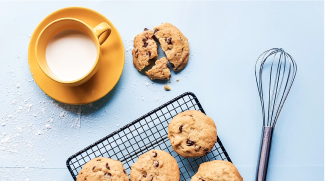If you were to look for Verdance on October 1st this year, you would have found nothing. This artist did not exist.
At the time of writing this article (Jan 5th), Verdance has been featured on 723 Spotify or Apple Music playlists and Shazamed nearly 200 times. In addition, it had written features on a number of prominent curators like Acid Stag (AU), The New Lofi (CA), Raver Rafting (US) Beatradar (DK), Rain City Sounds (CA), and Sidekick (US) - thanks to our network or using SubmitHub as a way to contact other fellow curators (full disclaimer - we're on there too).
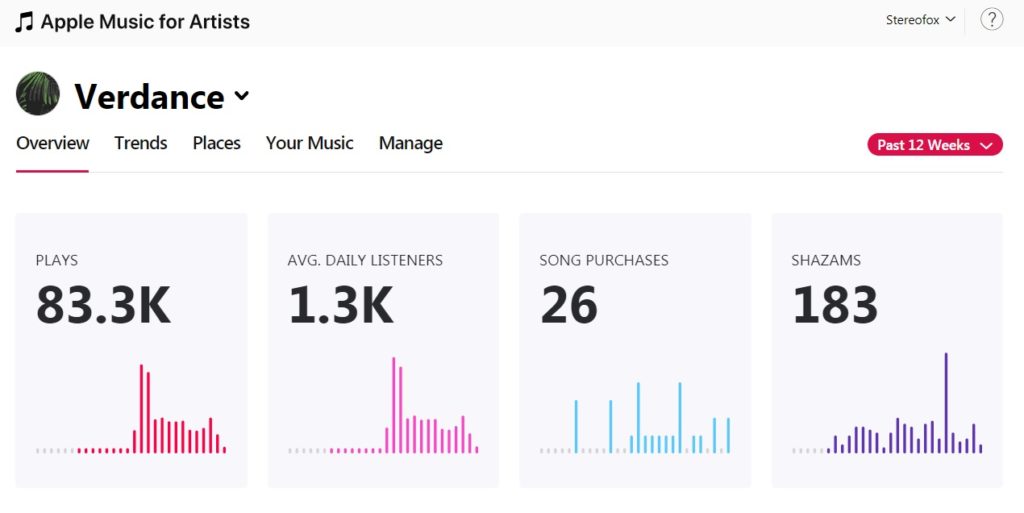
His debut single “Ritual Two” was featured on Spotify's Lounge - Soft House editorial - something which we were beyond excited about because that was the very first track we put out.
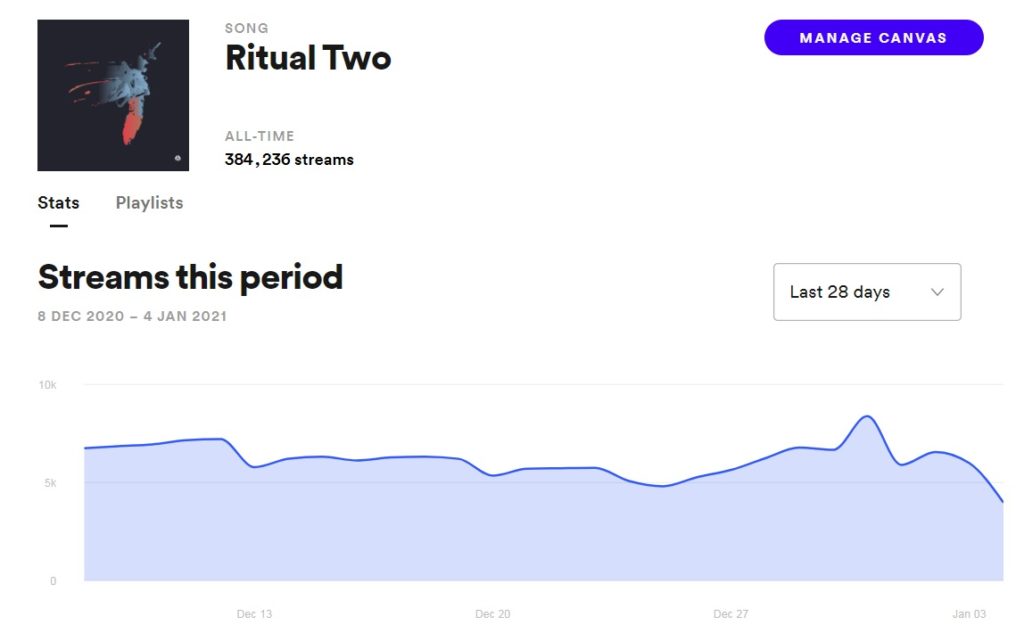
In addition, the album’s title track “Rothko” featuring Oli Hannaford made it on Apple Music’s New Music Daily, Living in the Library, Loops, and Future Sounds. Last, but not least Verdance was also featured in Dr. Dre’s Beats official Beats of the Week and got played on BBC Introducing. We’re also proud to announce that we were working with Platoon as a distributor on this release. A great experience and a set of professionals who valued the work we did together with Jake.
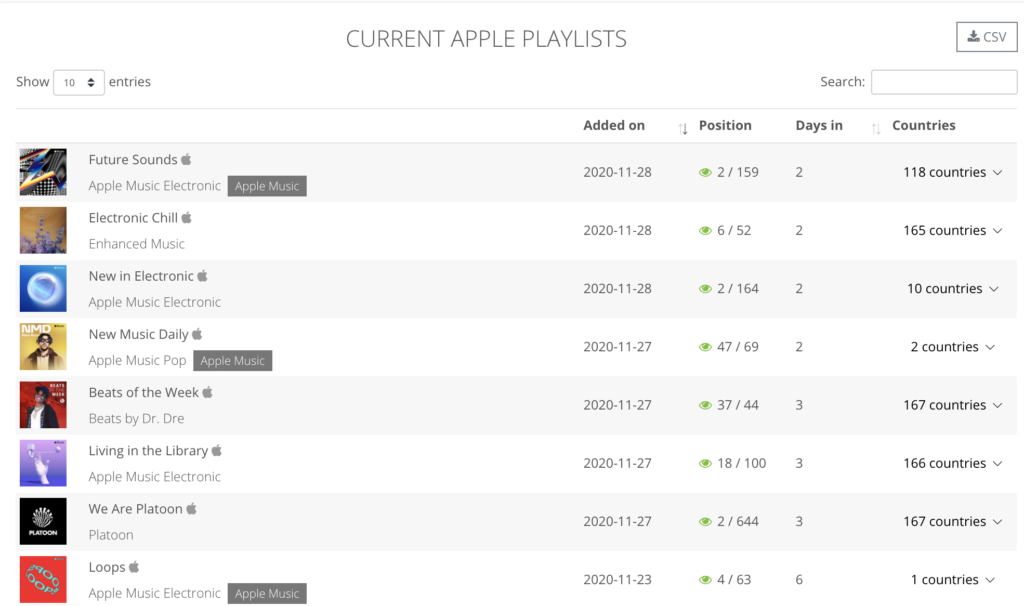
Number-wise we’re at almost 550k plays with nearly 100k monthly listeners so far. And another very important number - 100 followers (on Spotify that is). Why am I talking about followers? Because streams != fanbase. Building a fanbase takes time, consistency, and a lot of effort and it usually doesn’t happen overnight. By the way, if you want to stay up-to-date with Jake's work as Verdance follow him on Spotify here.
Stay up to date.
New music and exclusive updates in your inbox weekly.
The purpose of this article is to share our experience as a young label in building an artist from complete scratch, the importance of branding and consistency, shed light on some DOs and DON’Ts and talk about the intersection of creativity and data when it comes to the music industry.
We’re far from being perfect and we definitely didn’t have the chance/resources to look into all channels (TikTok, I’m looking at you), but as a music blog for 8 years and label for more than a year, we hope these observations help you in your journey going forward. We’re also always open to discussion, feedback and suggestions, so don’t hesitate to contact us.
It’s important to note that while Verdance is a brand new moniker, Jake is not new to the whole music thing. He has been releasing under the name Handbook for more than 10 years now and has been a prominent figure in the beat / instrumental hip hop scene. The good? He is quite experienced when it comes to the ins and outs of the industry. The bad? Verdance is not a full-time thing and creating proper social media planning and presence can be a bit challenging. That being said, I think we did quite well-using calendar planning and chopping some of the content into a number of posts.
Branding in Music and why it matters in 2020?
Regardless of the field you operate in, branding matters. It is a way to differentiate yourself and stand out. It is a way to be remembered and it is progressively becoming more and more important due the overabundance of content out there and lets not forget - while there’s tons of more music being released every day, the time people have to allocate to listening and actually paying attention does not change. Those 24 hours are here to stay.
A brand is anything that defines or represents you. It should be a reflection of you as an artist, your personality and your music and that’s what we tried to capture when we started working with Verdance.
Your brand attributes vary greatly - from your name, your logo, the colours you use, your online presence and posting style. Even the handle of your social media profiles or how you customize your links. Every little detail can make an impact on people. If we have to be specific here, we strongly advocate for using the exact same handle across all SM channels. It adds a certain feeling of care and definitely makes life easier, especially for those who you want to promote your music to. Sorry, but it’s hard to take someone with soundcloud.com/user-238238238 seriously.
In addition, making fanlinks a bit more informative and clean also helps a lot. Seeing http://bit.ly/boyan-reconnect instead of http://bit.ly/32ttsFA might seem like a minor thing, but to some is quite important when it comes to attention to details.
What we’re trying to say is that your brand is a vast set of tools designed for people to identify and remember you with.
There is one obvious, but important thing I want to point out before digging into the sub-topics. Your music is the most important brand attribute. No visual, story, font or animation will help you achieve the results you want if your music isn’t good or placed in front of the wrong audience.
We look at the brand as something that can only enhance or increase an artist's chance of success, but not a stand-alone key pillar necessary for that end goal.
Music Branding Checklist
While that checklist is actually a lot more extensive and you probably have heard most of these things, we’ll try to list the key things we made sure we cover.
Write a captivating bio
When in doubt, always put yourself in the shoes of a listener or curator. What’s better in case they end up on your profile? A blank space or a piece of engaging information and introduction to your world. As someone who has been writing about music I kinda lowkey dislike when seeing empty bios of artists. Or a few descriptive words without any meaning behind.
There have been cases where I simply don’t feature an artist just because I couldn’t find absolutely anything about them. It also feels a bit lazy at times.
Your bio will help current (and potential) followers build a meaningful connection with you. We try to write bios that describe an artist's musical background and life experiences, but that also carry a scent of emotional meaning. Your bio should give people a glimpse into who you are, where you've been and where you're going. Needless to say, there are tons of people who simply don’t care about that, but why not give those who actually care something to read?
When writing bio, we try to answer a few key questions and take it from there.
- Where are you from?
- How would you describe your music (both mood and genre-wise)?
- Any other artists you've worked with?
- Who do you think you sound like?
- What are your upcoming plans as an artist?
- Do you have any quotes or features you can use?
- What's one interesting / bizarre thing about you?
- What's the meaning behind your artist name (if there’s such)?
You can check Verdance’s artist bio on our label site or on Spotify below. We personally advocate for not more than a few paragraphs, especially if you're an up-and-coming artist. Something to trigger someone’s interest is absolutely more than enough.
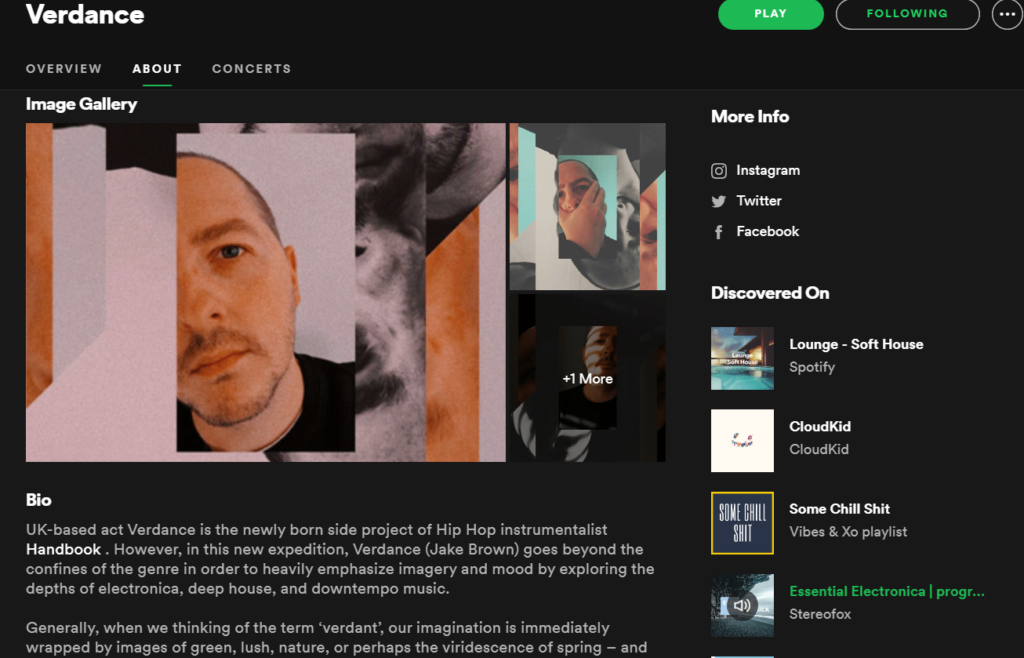
One more thing that’s important to add - tailor your bio based on the channel you’re writing it for. When Lu created the storyline of Verdance, we made sure we have a short and informative, and punchy version for Instagram and Twitter. It’s important to think about the purpose of each channel and how to best utilize the space on there.
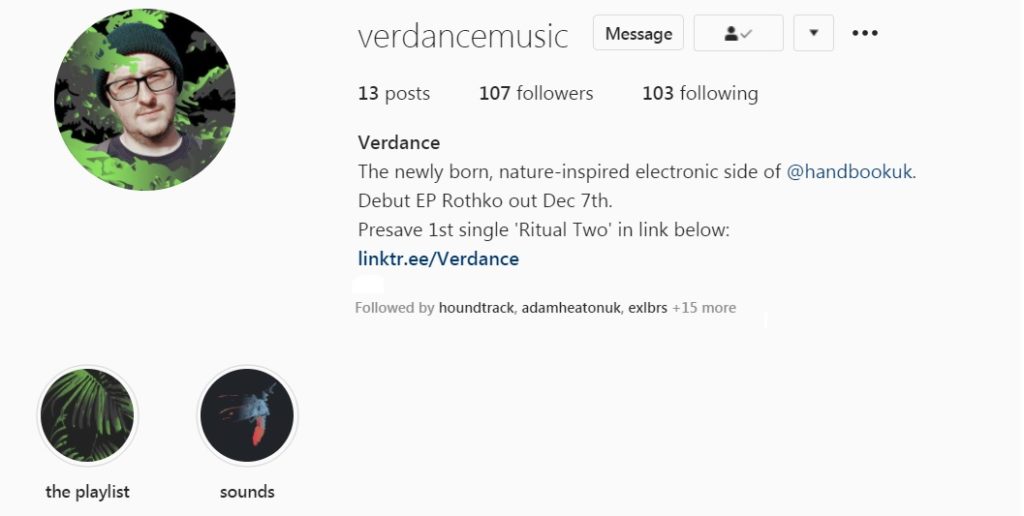
Build your image
Images and graphics are a key tool to help your fans build their perception of you and your music. Paying attention to the latest trends in design and thinking carefully about imagery, colours, fonts, and how they reflect who you are and your music are quite important.
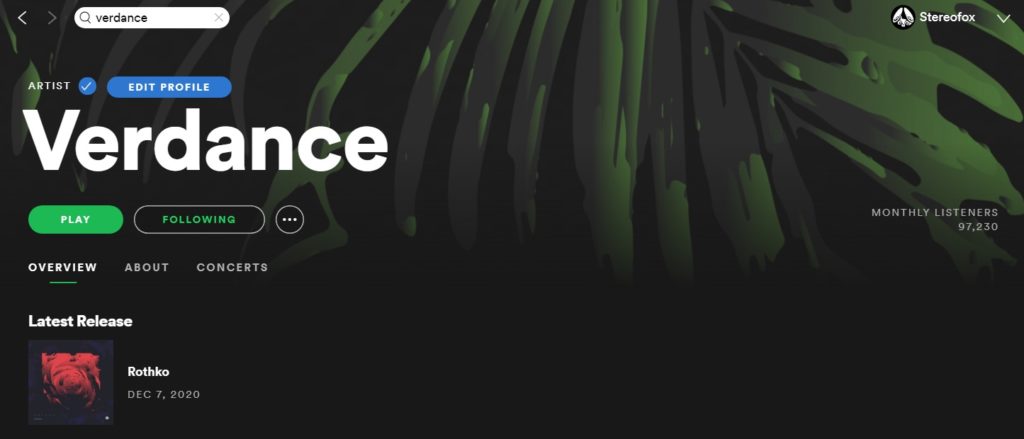
We wouldn’t advocate to blindly follow what’s hyped right now, especially if that’s just not who you are. The topic of imagery is a very complicated one, and if there are interested people, we might invite creative professionals to share their thoughts on the matter in the near future.
We’re perfectly aware that not everyone has the opportunity to hire a graphic designer or a photographer in order to translate their vision into reality. In case you’re starting out there are tools you can use to build decent visuals.
When it comes to the visual aspect, you can always use services like Unsplash in order to find visuals that reflect your branding. A piece of advice - stick to the same vibe / color scheme / filter and even stick to a selected few photographers in order to achieve consistency. Giving them a credit in your posts is also a nice touch and a gesture of respect to their art.
Before continuing we would like to give a shoutout to artists like Vesky and misc.inc who are doing great in terms of selecting spot-on imagery for their music. Also, if you're looking for more information and tips on building great Spotify canvases, we've got you covered.
Be consistent
The glue that puts everything together. Consistency is the thing we advocate the most for, not only when building an artist brand, but also when working on Stereofox itself. Being consistent helps your fans to easily identify you.
Always be in line with your work and branding across your channels, whether that’s your Spotify web app banner or your Instagram Stories highlights design. It is important that if people move from platform to platform, they easily recognize that’s you. Tycho is a great example for a consistent and well-thought brand. Scott is a designer by training, so that’s no surprise, but one thing’s for sure - you know a Tycho release when you see one. The graphics, the color schemes, the tiny details.
In general if you want to stay consistent, creating templates in Canvas or Figma and writing down guidelines for the future might be a good starting point.
Now let's talk about how this all went down in the case of Verdance.
Building The Verdance Story
This section is written by Lu, who was helping me with the story-telling behind Verdance.
The Importance of an Artist Narrative
Forming a narrative/story of an artist isn’t exactly the same as creating a bio (which we covered above). These two are related as an artist’s story can inform the bio although narrative goes beyond facts as we delve into the artist’s inspirations, struggles, triumphs, and even message if there is one.
There are two perspectives that we can look at which details the importance of a narrative – from the perspective of the audience and from the perspective of the artist. Having an authentic artist story that is presented in a riveting manner is one of the most effective ways audiences can relate to an artist’s music on a deeper level, and distinguish their work from other artists who may possess a similar sound.
From the perspective of the artist, it helps immensely with understanding what drives you and the kind of experience you’re welcoming your audience to. Your narrative could be a very big-picture look at your career as a whole, or you can create mini-narratives around much smaller events like a particular album/EP – much like Rothko.
How We Created the Verdance Brand Story
This is something that undoubtedly starts with the artist as they’d have to truthfully reflect on their journey. If this is initially created and/or fabricated by someone else it could come across as extremely disingenuous and not even relate to the music at all. So what we did is actually ask Jake a couple of questions that were relevant to the music and would steer him in the right direction to dig deep on what Verdance means to him and where he hopes to take the project. Here are some examples:
How did the name “Verdance” come about and in which way(s) does it represent your sound?
How are you trying to make people feel, or what kind of space do you want to put people in after they've experienced the EP?
Where do you see Verdance in the next 2/3 years?
Thankfully, Jake really went in-depth with his answers which gave us a lot to work with. We also included variations of his sincere answers in the bio and in some of the Spotify playlist pitches we drafted. A quote that really stood out was:
I want to create music that is warm, organic and full of striking, vivid melodies. Living in the city, I feel detached from nature at times, so Verdance creates an aural link to a world that I don't always get the opportunity to enjoy.
This hints that the music was born out of struggle, and this resulted in the creation of a sound that is nature-inspired. To wrap things up, asking the right questions about your journey as an artist is a sure-fire way to retrieve the ingredients to create your artist narrative. It’s how you present your honest findings that will determine if your audience will latch on.
The visuals
This section is written by Boris who was managing the visual direction and conceptualization of Verdance.
There’s a time when an artwork is an afterthought, or a necessity rather than the focus, and that’s not always a bad thing - different music is made to be consumed in a different way. There are also times where artists go through a lot of exploration before reaching their identity, or their nature is always changing.
Verdance was conceptually established very well way before we started discussing the visuals. It’s what makes it work musically, and it’s what makes it a blessing to work with when creating imagery.
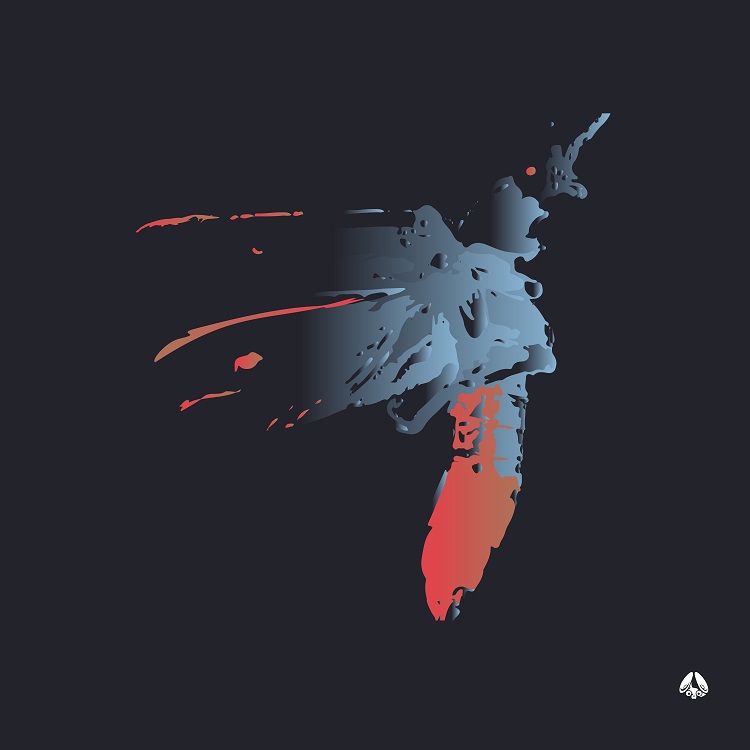
One of the main aspects of the EP that struck me is the duality you find in it, through and out. Jake describes it as a conflict in its words, one could find it more of a blend. As Sidekick reviewed Rothko:
If you find yourself conflicted by whether to dance, or even seclude yourself in order to become wanderlust in this journey… that’s perfectly alright as Rothko provides an explorative sensation that could be entered in numerous ways.
That duality is what we tried to capture when working on the imagery. Natural patterns of plants (verdant, remember?) and fireflies meet the clean, rhythmic digital world. Rich and detailed shapes presented with simplicity in just a few colours.

And when you have such consistency musically, it allows you to build a world where this story is told visually. What’s more, when you have a project so clear on a conceptual level, you can elevate that story and embed it into the artist’s brand and its overall visual representation.
Branding Checklist Done, Now What?
As we mentioned, building your brand should be an evergoing process, so there’s not really a I Am Done stage, but it’s okay to take a break and go with what you’ve got going on so far.
After establishing the basics it’s time to focus on building a following, telling your story, and releasing music. All of those topics are vast territory themselves, so we will definitely cave in some other time, but we hope what we’ve shared so far has been useful or at least inspirational.

